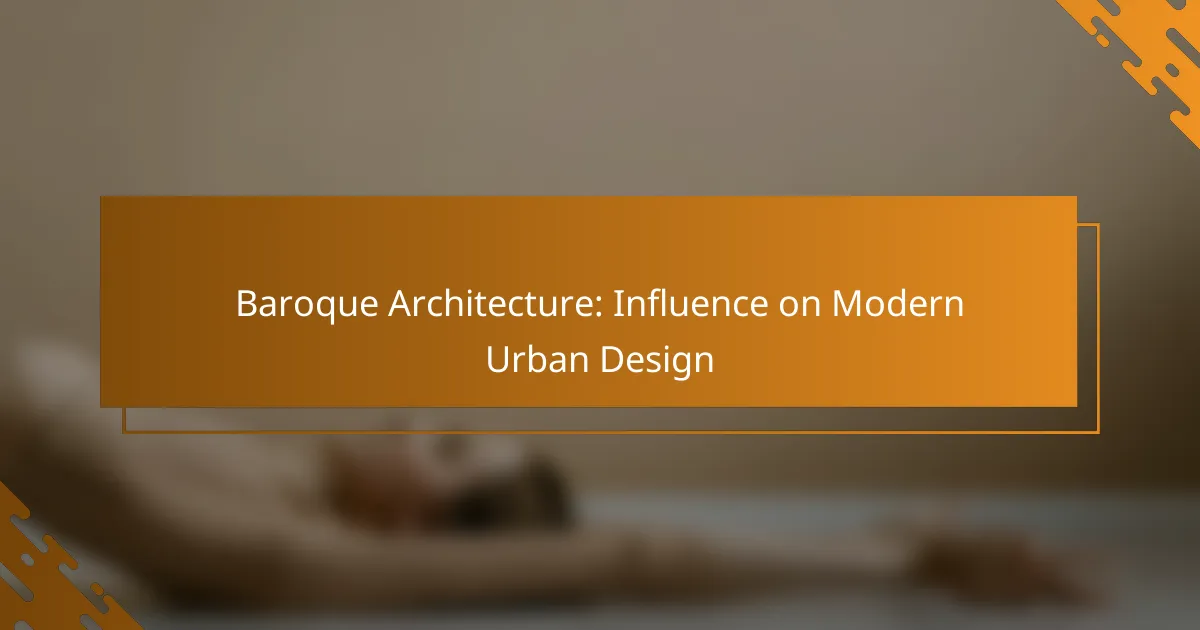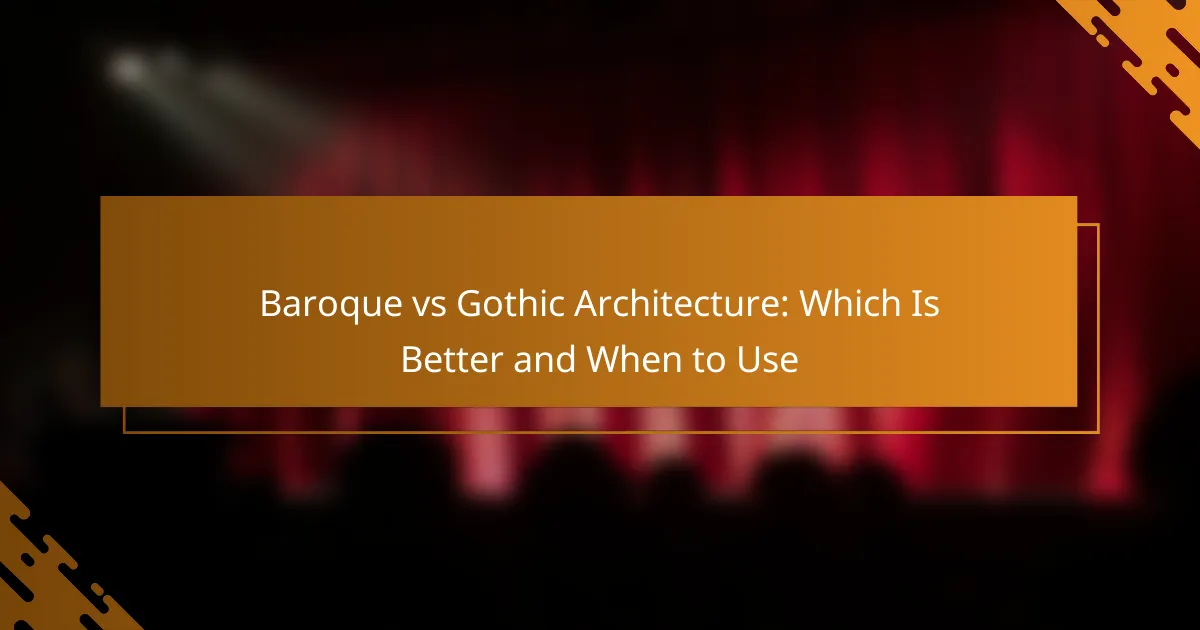Baroque architecture emerged in the late 16th century, characterized by its dramatic use of space, intricate details, and a sense of movement that conveys emotional intensity. This style symbolizes power and wealth through extravagant designs and elaborate ornamentation, often reflecting the authority of the ruling classes and the Church. Iconic examples, such as St. Peter’s Basilica and the Palace of Versailles, showcase the grandeur and opulence that define the Baroque period.
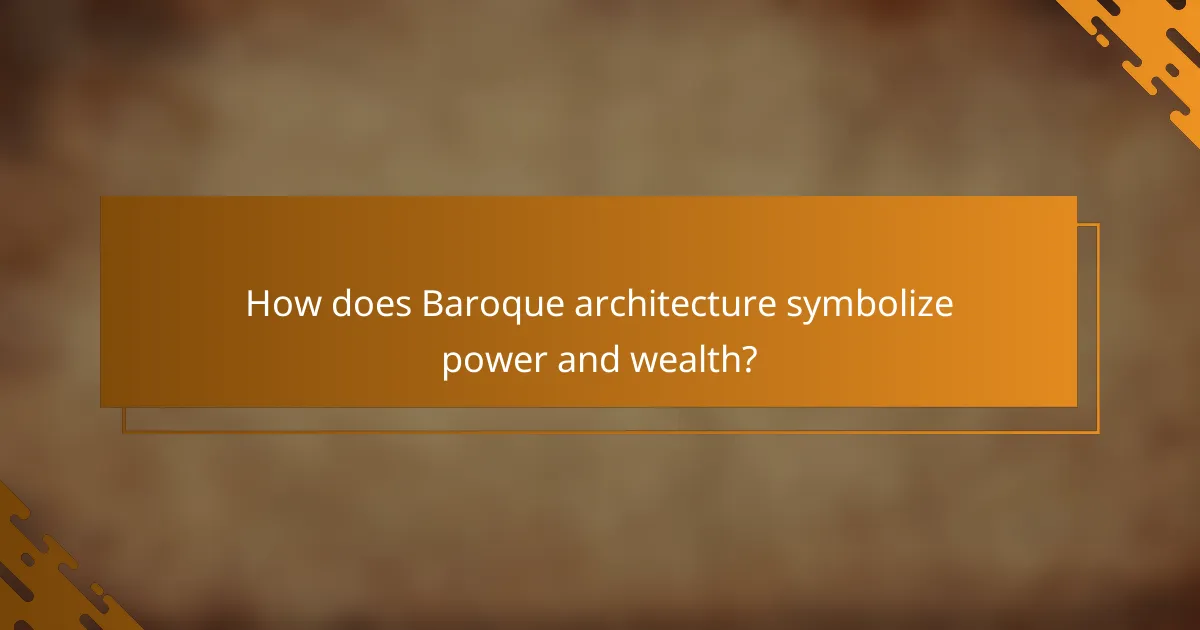
How does Baroque architecture symbolize power and wealth?
Baroque architecture symbolizes power and wealth through its extravagant designs and elaborate details that reflect the authority of the ruling classes and the Church. This style often features grandiose structures and opulent materials, creating an overwhelming visual impact that conveys dominance and affluence.
Grandiose structures
Baroque architecture is characterized by large-scale buildings that often dominate their surroundings. Examples include palaces, cathedrals, and government buildings designed to impress and inspire awe. Structures like St. Peter’s Basilica in Vatican City exemplify this grandeur, with their expansive façades and intricate interiors.
The use of space is also significant; Baroque architects often employed complex layouts that included sweeping curves and dramatic perspectives. This design approach not only enhances the visual experience but also symbolizes the power of the institutions that commissioned these works.
Use of opulent materials
Opulent materials are a hallmark of Baroque architecture, with builders frequently using marble, gold leaf, and elaborate frescoes to create a sense of luxury. These materials were often sourced from various regions, reflecting the wealth and resources of the patrons. For instance, the use of gilded decorations in churches and palaces served to elevate the spiritual and temporal authority of the Church and monarchy.
The lavishness of these materials also played a practical role; they were intended to impress visitors and convey a message of stability and prosperity. The more extravagant the materials, the greater the perceived power of the owner or institution.
Influence of religious institutions
Religious institutions were significant patrons of Baroque architecture, using it as a means to assert their influence and power. The Catholic Church, in particular, embraced this style during the Counter-Reformation to inspire devotion and convey the glory of God. Churches built in this period often featured grand altars, elaborate chapels, and dramatic lighting to enhance the spiritual experience.
This architectural style was not just about aesthetics; it was a strategic tool for the Church to communicate its authority and attract followers. The emotional impact of Baroque churches, with their intricate designs and rich decorations, aimed to evoke a sense of divine presence and reinforce the Church’s role in society.

What are the key characteristics of Baroque architecture?
Baroque architecture is characterized by its dramatic use of space, intricate details, and a sense of movement. This style emerged in the late 16th century and is known for its grandeur, emotional intensity, and elaborate ornamentation.
Dynamic shapes and forms
Dynamic shapes and forms are central to Baroque architecture, creating a sense of movement and fluidity. Buildings often feature curved lines, oval shapes, and complex geometries that draw the eye and evoke emotion. For instance, the use of ellipses and undulating surfaces can be seen in structures like St. Peter’s Basilica in Vatican City.
Architects utilized these dynamic forms to enhance the viewer’s experience, making spaces feel more alive and engaging. This approach contrasts sharply with the rigid symmetry of earlier architectural styles, allowing for a more expressive and theatrical environment.
Ornate decoration
Ornate decoration is a hallmark of Baroque architecture, with elaborate details adorning both the interiors and exteriors of buildings. This includes intricate carvings, gilded elements, and lavish frescoes that convey grandeur and opulence. Notable examples include the Palace of Versailles in France, where decorative arts are integrated into the architecture.
These decorative features often serve symbolic purposes, reflecting religious themes or the power of the ruling class. When designing Baroque structures, it is essential to balance decoration with structural integrity to maintain the overall aesthetic appeal.
Contrast of light and shadow
The contrast of light and shadow plays a crucial role in Baroque architecture, enhancing the dramatic effect of spaces. Architects strategically designed windows, domes, and vaults to manipulate natural light, creating striking visual contrasts that highlight architectural features. This technique can be observed in the works of Francesco Borromini, who expertly used light to define forms.
Effective use of light and shadow not only adds depth to the structure but also influences the mood of the space. When planning a Baroque design, consider how light interacts with surfaces and how it can be used to accentuate key elements within the architecture.
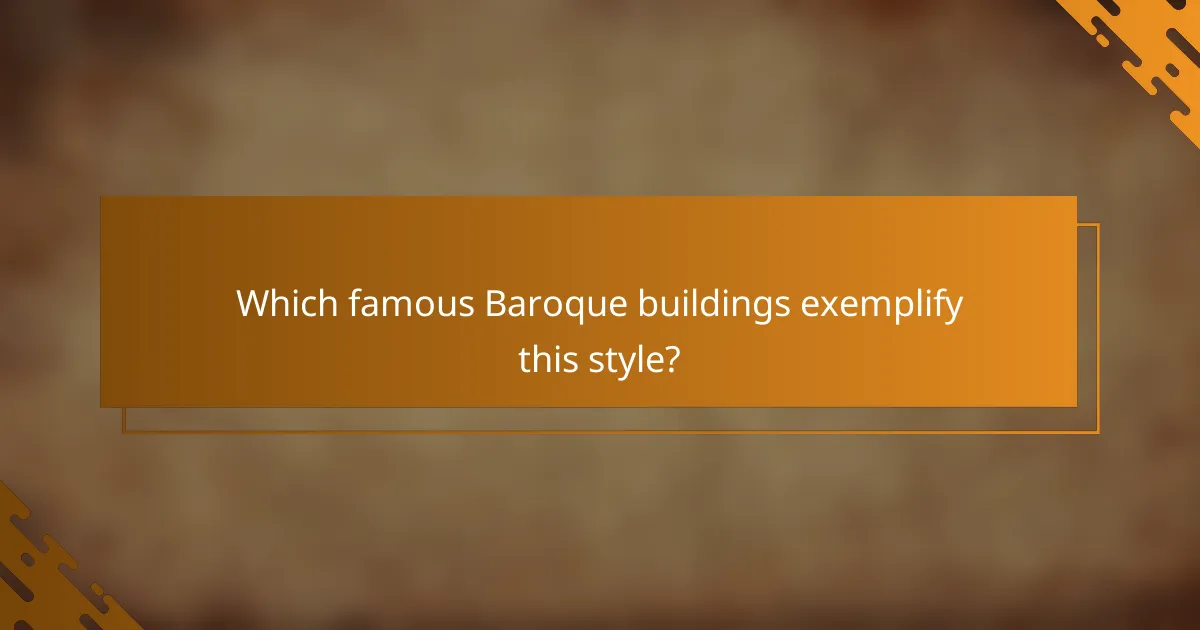
Which famous Baroque buildings exemplify this style?
Several iconic Baroque buildings showcase the grandeur and intricate design characteristic of this architectural style. Notable examples include St. Peter’s Basilica, the Palace of Versailles, and the Church of San Carlo alle Quattro Fontane, each reflecting the opulence and detailed artistry of the Baroque period.
St. Peter’s Basilica in Vatican City
St. Peter’s Basilica is one of the most significant examples of Baroque architecture, renowned for its massive dome and elaborate façade. Designed by architects like Michelangelo and Bernini, it combines classical elements with dynamic forms, creating a sense of movement and grandeur.
The interior is equally impressive, featuring ornate decorations, stunning mosaics, and the famous Pietà sculpture. Visitors often note the basilica’s ability to inspire awe through its scale and artistic detail.
Palace of Versailles in France
The Palace of Versailles epitomizes Baroque opulence, originally built as a hunting lodge before transforming into a grand royal residence. Its symmetrical layout, expansive gardens, and lavish interiors reflect the power and wealth of the French monarchy.
Key features include the Hall of Mirrors, adorned with crystal chandeliers and gilded decorations, and the meticulously designed gardens, which emphasize the relationship between nature and architecture. Versailles remains a symbol of absolute monarchy and Baroque artistry.
Church of San Carlo alle Quattro Fontane in Rome
The Church of San Carlo alle Quattro Fontane, designed by Francesco Borromini, is a prime example of Baroque innovation in church architecture. Its unique oval shape and undulating façade create a dynamic visual experience, showcasing the era’s departure from traditional rectangular designs.
Inside, the church features intricate stucco work and a dramatic use of light, enhancing the spiritual atmosphere. This building illustrates how Baroque architecture can evoke emotion and convey religious significance through its form and decoration.
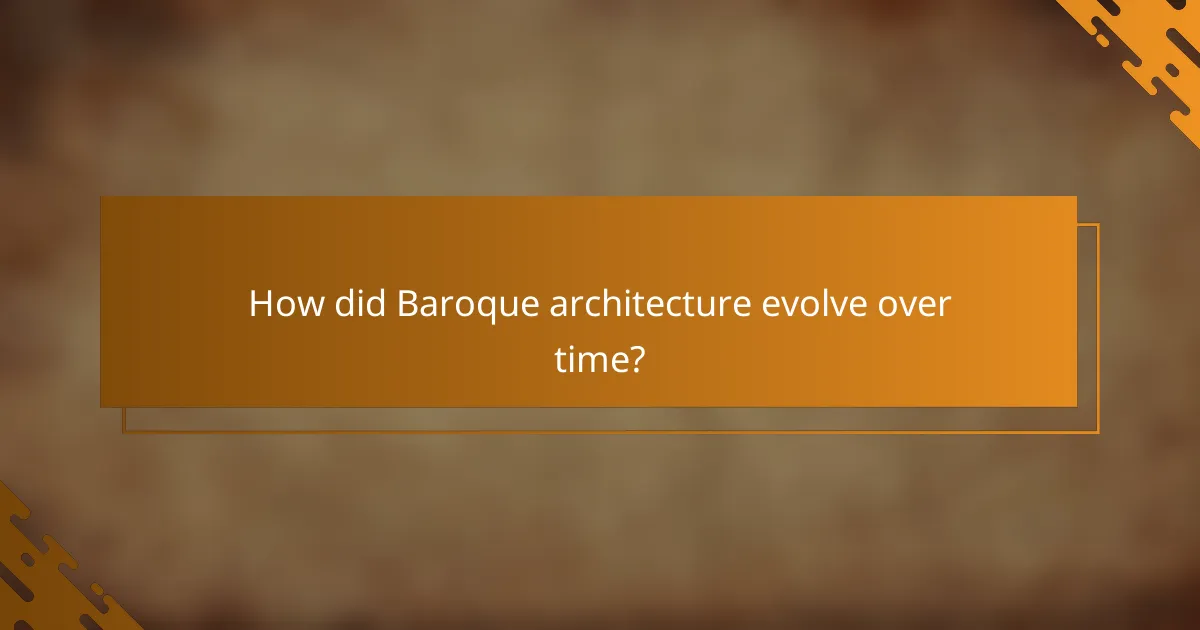
How did Baroque architecture evolve over time?
Baroque architecture evolved from the Renaissance style in the late 16th century, characterized by dramatic expression and grandeur. It continued to develop through the 18th century, influenced by cultural, religious, and political changes across Europe.
Transition from Renaissance to Baroque
The transition from Renaissance to Baroque architecture marked a shift from harmony and proportion to a focus on emotion and movement. While Renaissance buildings emphasized symmetry and classical forms, Baroque structures introduced dynamic shapes, elaborate decorations, and a sense of theatricality.
Architects like Gian Lorenzo Bernini and Francesco Borromini played crucial roles in this evolution, utilizing bold curves and intricate details to create visually striking compositions. This shift reflected broader cultural changes, including the rise of absolute monarchies and the desire for grandeur in public spaces.
Regional variations in Europe
Baroque architecture varied significantly across Europe, adapting to local tastes and cultural contexts. In Italy, the style was characterized by ornate facades and grand interiors, while in France, it often featured classical elements combined with elaborate gardens, as seen in the Palace of Versailles.
In contrast, the Spanish Baroque style emphasized dramatic contrasts and religious fervor, evident in structures like the Cathedral of Santiago de Compostela. Northern European countries, such as the Netherlands, showcased a more restrained approach, focusing on functional design and less ornamentation.
Influence of the Counter-Reformation
The Counter-Reformation significantly influenced Baroque architecture, as the Catholic Church sought to reassert its power and appeal to the faithful. This led to the construction of grand churches and cathedrals designed to inspire awe and devotion, such as St. Peter’s Basilica in Vatican City.
Architects incorporated elements like expansive domes, dramatic altarpieces, and elaborate frescoes to create immersive spiritual experiences. The emphasis on emotional engagement and visual splendor was a direct response to Protestant Reformation critiques, aiming to draw worshippers back to Catholicism.

What are the cultural influences on Baroque architecture?
Baroque architecture is shaped by various cultural influences that reflect the artistic and social currents of its time. Key influences include the Italian Renaissance, the colonial expansions of Spain and Portugal, and the integration of classical elements, all of which contributed to the distinctive features of Baroque design.
Italian Renaissance roots
The Baroque style emerged from the Italian Renaissance, which emphasized harmony, proportion, and the revival of classical antiquity. Architects like Michelangelo and Palladio set the stage for Baroque by exploring dynamic forms and spatial relationships, paving the way for the more dramatic expressions of Baroque architecture.
Baroque architecture took Renaissance principles and exaggerated them, introducing bold curves, elaborate ornamentation, and a sense of movement. This shift aimed to evoke emotional responses and create awe, reflecting the power of the Church and the state during this period.
Spanish and Portuguese colonial impact
The Spanish and Portuguese empires played a crucial role in spreading Baroque architecture across their colonies, particularly in Latin America and parts of Asia. This influence resulted in unique adaptations of the Baroque style, integrating local materials and indigenous designs.
In regions like Mexico and Peru, Baroque churches often featured intricate facades and lavish interiors, blending European styles with native artistry. This fusion not only showcased the power of colonial rule but also reflected the cultural syncretism of the time.
Integration of classical elements
Baroque architecture is characterized by its integration of classical elements, such as columns, pilasters, and domes, but reinterpreted in more expressive ways. While maintaining a connection to classical architecture, Baroque designers used these elements to create a sense of grandeur and drama.
For example, the use of large-scale columns and expansive domes in Baroque churches, like St. Peter’s Basilica in Rome, exemplifies this integration. The goal was to inspire awe and convey the glory of the divine, making architecture a powerful tool for both religious and political expression.
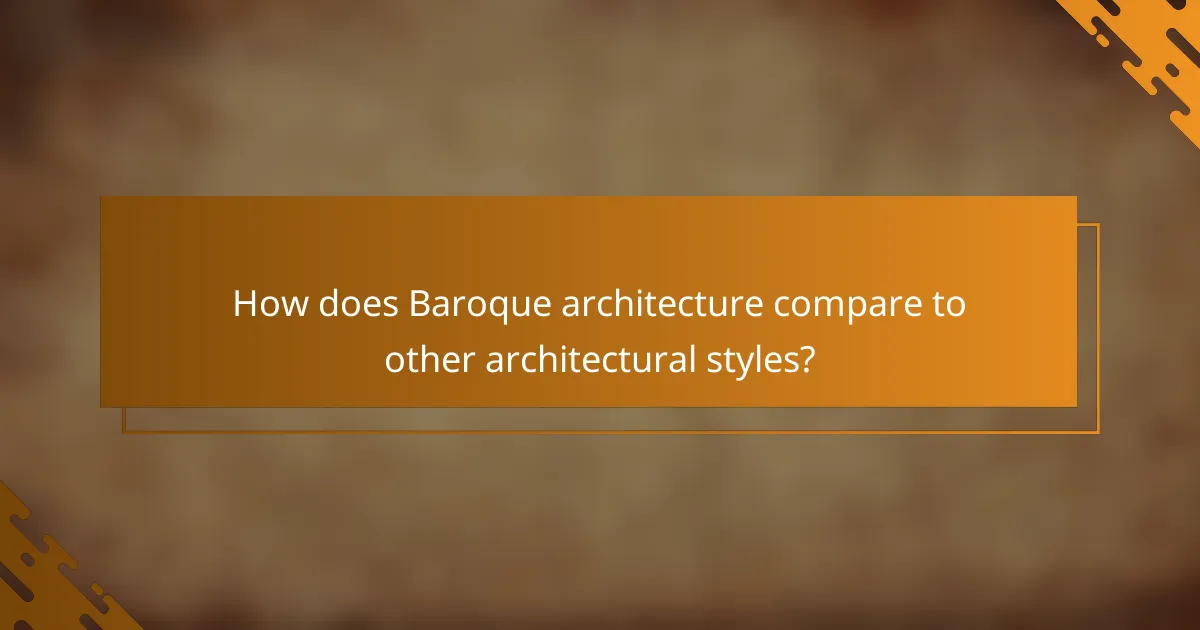
How does Baroque architecture compare to other architectural styles?
Baroque architecture is characterized by its grandeur, dramatic use of light and shadow, and intricate details, setting it apart from other styles like Renaissance and Gothic. While Renaissance architecture emphasizes symmetry and proportion, Baroque takes these elements further by incorporating dynamic shapes and elaborate decorations.
Key Characteristics of Baroque Architecture
Baroque architecture features bold forms, vibrant colors, and a sense of movement. Common elements include large-scale ceiling frescoes, ornate columns, and expansive staircases. The style often employs a contrast of light and dark to create a dramatic effect, enhancing the viewer’s emotional experience.
Comparison with Renaissance Architecture
Renaissance architecture focuses on harmony, proportion, and a return to classical antiquity, emphasizing balanced forms and restrained decoration. In contrast, Baroque architecture embraces complexity and extravagance, often using curves and elaborate ornamentation to evoke emotion and awe.
Comparison with Gothic Architecture
Gothic architecture is known for its verticality and the use of pointed arches, flying buttresses, and stained glass. Baroque architecture, while still monumental, shifts the focus from vertical lines to dynamic shapes and intricate details, creating a more theatrical and immersive experience.
Regional Variations in Baroque Architecture
Baroque architecture varies significantly across regions, influenced by local cultures and materials. For instance, Italian Baroque is often more theatrical and ornate, while Spanish Baroque incorporates local motifs and colors. In contrast, Central and Eastern European Baroque may reflect a blend of local traditions with the grand styles of Italy.

